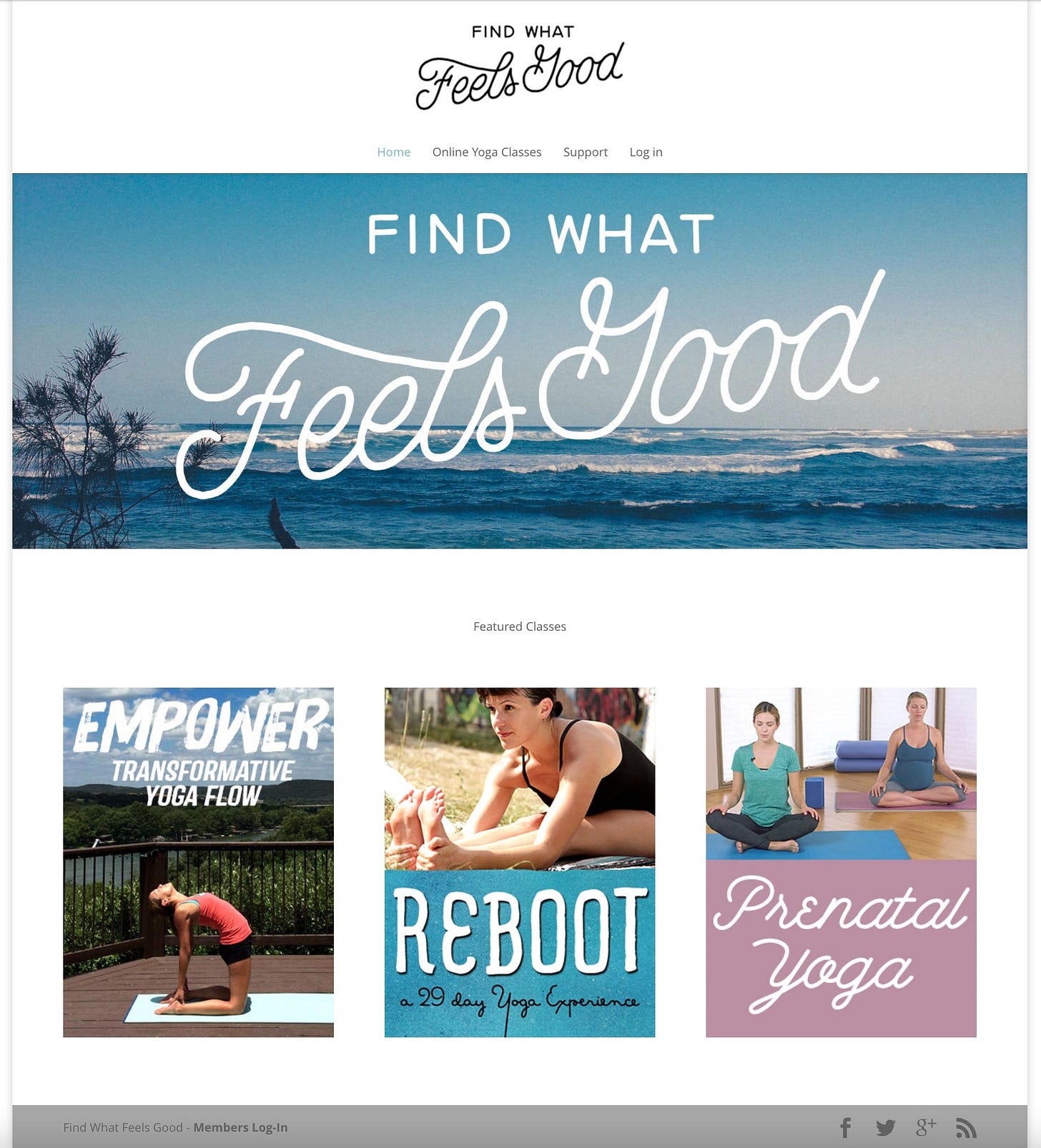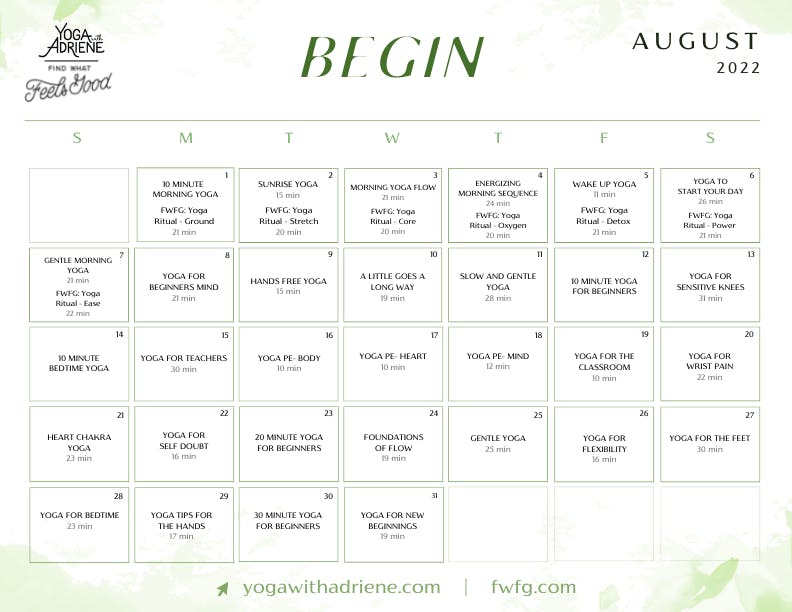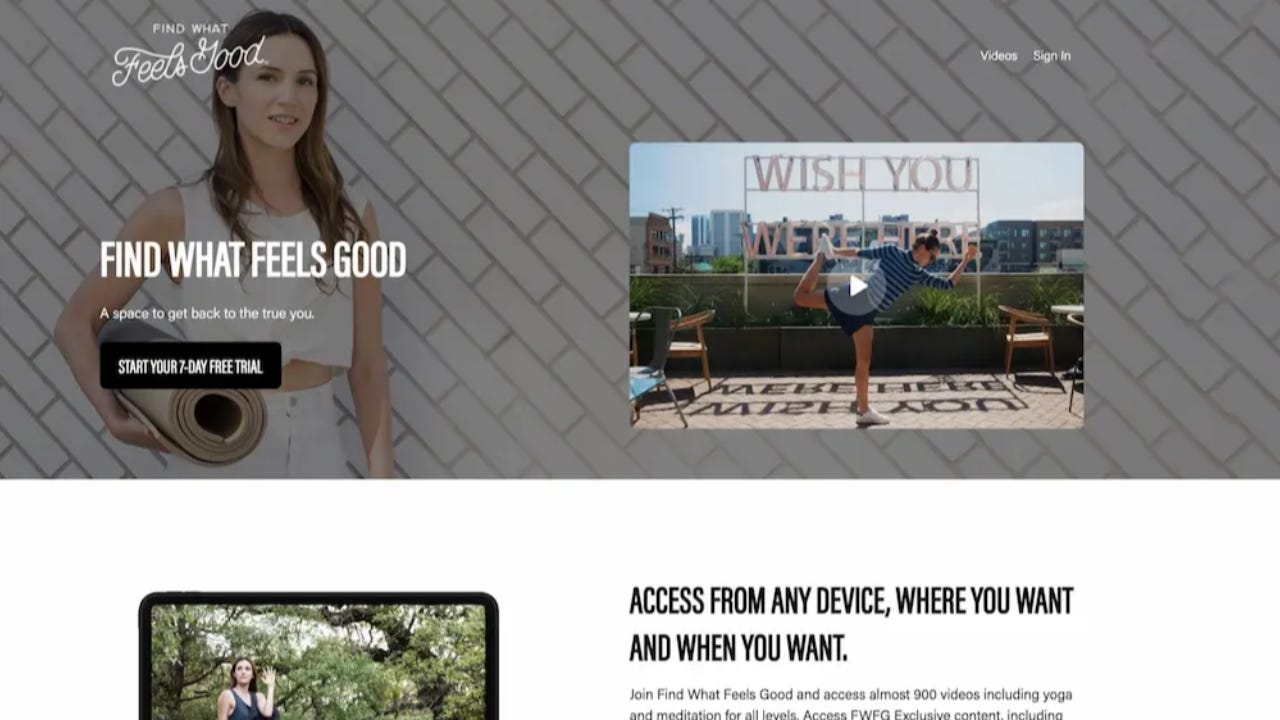How We Built a 7-Figure SVOD Business From a YouTube Channel
Learn how we used a YouTube channel to launch a thriving subscription video-on-demand (SVOD) platform with over 50,000 members — with ZERO paid ads.
The Yoga With Adriene YouTube channel is still what I’m most well-known for, and I’ve already written a lot about it here. But another of our projects is a little more under the radar — even though it’s a huge success (and generates 70% of our revenue).
I’m talking about our SVOD service: Find What Feels Good.
WTF is SVOD?
SVOD is an acronym for Streaming Video On Demand. It’s a membership site where the majority of the content is video. Internet entrepreneurs (and pornographers) have been creating these from the moment video streaming was possible, even when it barely worked. Once bandwidth increased and video got easier, the entertainment industry got involved. The “suits” needed a new term that would look tidier on an Excel spreadsheet; thus, SVOD was born.
You’ll frequently hear the term OTT, which stands for Over The Top, in conjunction with SVOD. That means there is an app that makes SVOD accessible through TVs.
FWFG features the entire YWA library (ad-free) and all our standalone courses. We’re also adding exclusive content weekly. As of this writing, we have over 50,000 members, and the number continues to grow.
We run the entire thing through a platform called Uscreen. It’s an all-in-one platform for the website, mobile, and TV apps. It’s a video-centric CMS that makes it easy to organize and publish content.
We upload a video, add a thumbnail and metadata, and click publish. BOOM! It’s immediately available everywhere.
But it wasn’t always so easy.
2015. An accidental SVOD.
In 2015, the YouTube channel was just three years old. YouTube was finally bringing in a little revenue, but it wasn’t consistent, and we weren’t sure it was dependable. The AdSense revenue was nothing compared to the exclusive courses we had been launching. At that point, Reboot, Prenatal Yoga, and Empower were available. We were gearing up to launch Rise: Morning Yoga.

To sell these courses, we had spent a few years muddling our way through various systems that I had cobbled together with WordPress and various membership plugins. The experience was terrible, took a lot of time, and was a customer support nightmare.
Then we heard about a new company called VHX. (Unfortunately, it no longer exists)
VHX was an all-in-one system for selling video content. It was years ahead of its time. It was created by a group of independent filmmakers who built it to sell their movies. Once we discovered it and talked to them, we moved everything over. We loved the team and the platform.
Our revenue immediately increased, and our customer support issues dropped to almost zero. It was also so well-designed that it was a delight to use.
We had been selling standalone courses for a few months when the team at VHX reached out to us. They were preparing to release a new subscription feature (SVOD). It would be a complete system – not just the website but a full suite of custom apps for iOS, Android, Roku, etc.
Since we were already one of their biggest customers, they asked if we’d consider being one of their first beta clients for the subscription service.
And they offered to set all of it up for free.
We weren’t ready. Or were we?
We loved the idea, especially the idea of having our own apps, which was a rarity for small creators then. However, we didn’t think we had enough content for a viable subscription service. But it was exciting to think about.
In fact, it was so exciting that I couldn’t stop thinking about it.
I was confident that this was the direction our industry was moving in, and I didn’t want to miss out on this opportunity.
So we came up with a plan. We decided to offer our three existing courses, the upcoming course that people were already excited about, and the entire Yoga With Adriene content library ad-free. We even had a handful of videos that had received weird copyright strikes on YouTube that we had taken down. We decided to add those as well. And to round it out, Adriene was going to create monthly vlogs.
We decided to launch with that, and if everything went well, we’d devise a plan to create more exclusive members-only content. We decided to price it at $10/month.
We got to work uploading and organizing videos on VHX. We worked with the team to create the apps. Slowly but surely, it was coming together. It was very cool.
We weren’t sure how our community would respond. If you have spent much time in the YouTube ecosystem, you’ll know that putting a price tag on anything can be tricky. It’s not as bad now, but in 2015, you couldn’t sell much without being called a sell-out.
Luckily, we had an email newsletter and a blog.
The Launch
In November 2015, we wrote about the new direction and opened the doors as a soft launch.
There were a few unhappy people, and they made sure to let us know about it in the comments. Those are always a little hard to take since we had worked so hard on it and knew our hearts were in the right place. The negativity caused us to second-guess ourselves and wonder if we had made the right decision.
If we had only been paying attention to the comments, we might have shut the whole thing down and returned to standalone courses.
But sales were coming in, and the new members were excited about the new platform. This brought in a new wave of people who had never purchased anything from us before. The new platform was bringing in a new audience.
By the end of the first 24 hours, we had over 500 members.
And people continued to sign up.
At a $10/month price, we were making an additional $5,000 in monthly recurring revenue.
This revenue didn’t depend on the whims of the YouTube algorithm or how well we executed a course launch. These founding members had expressed confidence in our work.
It re-energized us.
Now it was up to us to keep these people happy, engaged, and benefitting from the videos.
This was a new world; as usual, we had no idea what we were doing.
How much new content should we publish? What the hell is a churn rate? How do we organize everything so that it’s not overwhelming? How do we balance this with the YouTube channel? How do we promote it without annoying people?
From 500 to 27,000 members
The obvious plan would be to start creating new membership videos every week. But we didn’t have the bandwidth for that at the time.
Instead, we decided to prioritize quality over quantity and focus on the community experience.
I hoped this would also help us avoid the issue of content overwhelm. Content Overwhelm is one of the leading reasons members cancel a subscription service. They log on and see a screen full of videos, get overwhelmed by the options, and are unsure what action to take. Many give up, close out, and are more likely to cancel. They’re not getting the experience they hoped for when they joined.
More content isn’t always the answer.
Our strategy: We would continue to do what we had already been doing, create several high-quality standalone courses per year, and work to create a sense of community around them.
Each course would get a proper promotional launch. We would make some of them available for standalone purchases as we had in the past. You could buy the course for $49 or get it as part of a $10/month membership and the rest of the video library. Plus, there was a free 7-Day trial to try the whole thing out.
Luckily, we had a great new course almost ready to launch. We also had a 3-video series we had recorded at a retreat in Nicaragua. Adriene’s monthly vlogs would supplement these and put everything in context. This was all on top of the complete YWA library (ad-free) and the previous premium courses.
We had one other ace up our sleeve.
A few months earlier, a community member had started creating yoga calendars. Our previous courses had calendars, but we’d never done anything for our regular videos.
In January, we contacted her and offered to pay her to keep creating these calendars. We soon hired her as our Community Manager.
Sarah created a theme for each month and suggested a daily yoga practice. The calendars were downloadable PDFs with clickable links for each day. Sarah shared them with the community every month—for free. People loved them!
In the beginning, the calendars only linked to free YouTube videos. As an experiment, we also highlighted some of the membership content. People started to click through and check out what we were up to on the membership.

We weren’t selling; we were providing valuable content. And it worked. With zero advertising, the membership started to grow.
This free PDF calendar now gets millions of downloads per month.
It’s also responsible for driving traffic to the membership every day. If a video is on the calendar, it immediately gets thousands of views – even if it’s available on YouTube for free.
In its first four years, the membership grew from 500 members to 27,000 members. This was with zero paid advertising. We only used the calendar, a weekly email, and links in the YouTube description.
Launching any membership can be daunting. We didn’t think we were ready, we didn’t think we had enough content, and we didn’t think we had a big enough audience.
But it worked.
This brings us up to 2018. There is more to this story, but I’ll save that for next time.
If you have any questions about membership sites or SVOD, please ask, and I’ll do my best to answer them. I genuinely believe that recurring revenue can be a key component in the success of any business, and there are many different ways to approach it.
As part of my ongoing experiment with Substack, I’ve opened a chat for this newsletter's readers. I reserve the right to turn it off anytime if it becomes unmanageable. For now, let’s use it as another way to connect.
So if there’s anything you’d like to ask or talk about, let me know. I’ll answer as many as I can in the chat or comments, and if I think any of them need a more detailed response, I’ll answer them here.
Catch you in the chat room,
Chris






